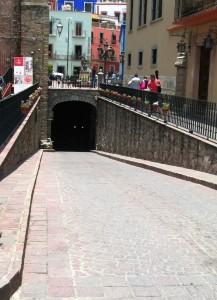Ever since narco kingpin Joaquín (“El Chapo”) Guzmán presumably sashayed out of his cell in a top-security Mexican prison last month through a sophisticated mile-long tunnel seemingly made expressly for him for this purpose, I’ve been thinking a lot about tunnels – in all their forms.
No one here in Guanajuato, Mexico, where I’ve been living this summer, would have been the least bit surprised by Guzmán’s method of escape. A tunnel? Why, of course! I can hear them thinking (then laughing). Guanajuato, one of the most beautiful and enchanting cities in all of Mexico, once a wealthy silver-mining town, is riddled with tunnels. Long, spaghetti-like, crisscrossing tunnels, dynamited out of solid rock, are a way of life here.
According to the website www.guanajuatomexicocity.com, Guanajuato’s tunnels are a “series of wide channels that extend under the city and help divert traffic” away from el centro. These tunnels were not initially constructed for traffic but rather as a diversion for the Rio Guanajuato to prevent flooding in this bowl-like city during the rainy season (July and August). “Few other cities in the world can boast such an elaborate method to both hide and limit traffic,” the website claims.

As I mentioned in an earlier post (“Storybook Walks,” July 15), I hold my breath when going through these tunnels in a taxi or car. Call it a touch of claustrophobia – or sheer terror of being buried alive – but I find these tunnels terrifying. The light at the end never looked so bright to me.
So what is it about tunnels that both frightens and fascinates us, I’ve been wondering?
On the plus side, there are the Tunnels of Love found all over the world – beautiful, outdoor, arbored stretches where lovers walk hand in hand in dappled light – or the old, late-19th century amusement park rides, where young, especially unmarried, couples could sit in little gondolas and smooch in the privacy and darkness of the ride at a time when public displays of affection were more than frowned upon.
And then there are the tunnels of desperation, like the Eurotunnel has become, as I read about in today’s New York Times: “Since the beginning of June, ten migrants have died near Calais, France, trying to hitch a clandestine ride through the Eurotunnel to Britain, their dream destination” (Editorial, August 2, 2015).
Of course, too, there are the tunnels dug to transport illegal drugs across (or, rather, under) borders, a practice Guzmán’s cartel has perfected. “He [Gusmán] did not invent smuggling tunnels,” says Monte Reel in an excellent new New Yorker piece entitled “Underworld: How the Sinaloa Drug Cartel Digs its Tunnels,” “—bank robbers, rumrunners, and guerrillas had used them for decades – but his criminal enterprise […] has refined the art of underground construction and has used tunnels more effectively than any criminal group in history. In the past quarter century, officials have discovered 181 illicit passages under the U.S.-Mexico border.”
In my ongoing groping for wisdom at this stage of my life, I turn to literature to shed more light on the subject of tunnels for me. Tunnels, in literature, often appear as representations of journeys and passages – a journey from one place to another, both physically and symbolically, or a passage from one phase of life to another. The tunnel, too, might represent a test, something the protagonist must get through, to find the light (enlightenment?) at the far end.
I’d like to think that I could live in a world without deep, dark, terrifying tunnels. But that’s just not realistic – especially here in Guanajuato. The tunnels here are necessary for getting from one place to another. And, like other life lessons, they pull me toward the light.

Did you read my mind, Bonnie? I was just thinking this morning that I hadn’t read one of your missives from Mexico for too long. What a luxury to take off on a tunnel tangent. Loved it!
Thank you so much, Barb! “Tunnel tangent” indeed! I’ve had tunnels on my mind…